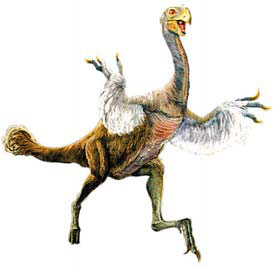| Home / China / Sci&Tech / News | Tools: Save | Print | E-mail | Most Read |
| Scientists Catch the Early Bird |
| Adjust font size: |
Chinese scientists have discovered a missing link in the evolutionary path between dinosaurs and birds.
Gigantoraptor erlianensis had a small head, a beak, slim hind legs, a massive body - the size of a Tyrannosaurus - and was covered with feathers. It couldn't fly, but it ran like the wind across the plains of North China 85 million years ago. It was 8 meters long, 5 meters tall and weighed about 1.4 tons. Fossil specimens were unearthed in the Inner Mongolia Autonomous Region about two years ago but the evolutionary link between the dinosaur and the bird family is being officially released only today, in Nature magazine. "It is unique because the dinosaur has a bird's features, but a much larger body than other known bird-like dinosaur species living earlier or later," said Xu Xing, a paleontologist from the Institute of Vertebrate Paleontology and Paleonanthropology affiliated to the Chinese Academy of Sciences. Gigantoraptor belonged to the Oviraptorosauria family, dinosaurs which lived in the Late Cretaceous period (about 65 to 100 million years ago). Although paleontologists found no direct evidence of feathers on the new fossil specimen, they infer that Gigantoraptor probably had feathers on its body, at least on its arms and tail, because of its close relationship to other feathered species such as Caudipteryx. Gigantoraptor's huge size also challenges old theories. Paleontologists used to believe that the evolution of the bird's features was related to the size of dinosaurs. "But this new dinosaur is an exception. It's features are different from other smaller dinosaurs of the same family, such as longer forelimbs," Xu said. Gigantoraptor lived in the time when Oviraptorosauria emerged about 130 million years ago and reached its population peak about 70 million years ago. The earliest birds emerged around 150 million years ago. The discovery means the evolutionary path leading dinosaurs toward birds was actually more varied than previously thought. The research team uncovered almost 80 percent of the dinosaur in sedimentary rocks of the Late Cretaceous period in Erlian Basin. Before the discovery of Gigantoraptor, the largest feathered animal was Stirton's Thunder Bird (Dromornis stirtoni) that weighed 500 kg and lived in Australia 6 to 8 million years ago. Inner Mongolia's Erenhot, the city where the dinosaur fossils were discovered, is planning to build a dinosaur museum to attract more tourists to the region. (China Daily June 14, 2007) |
| Tools: Save | Print | E-mail | Most Read |
 |
| Related Stories |
